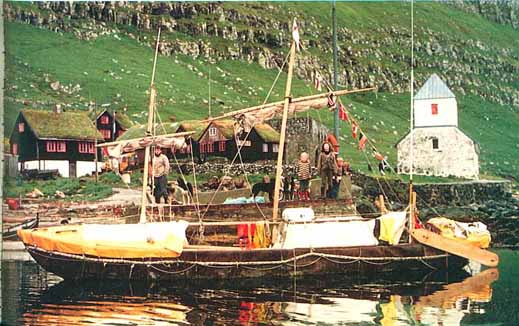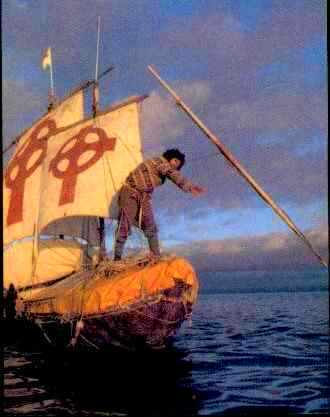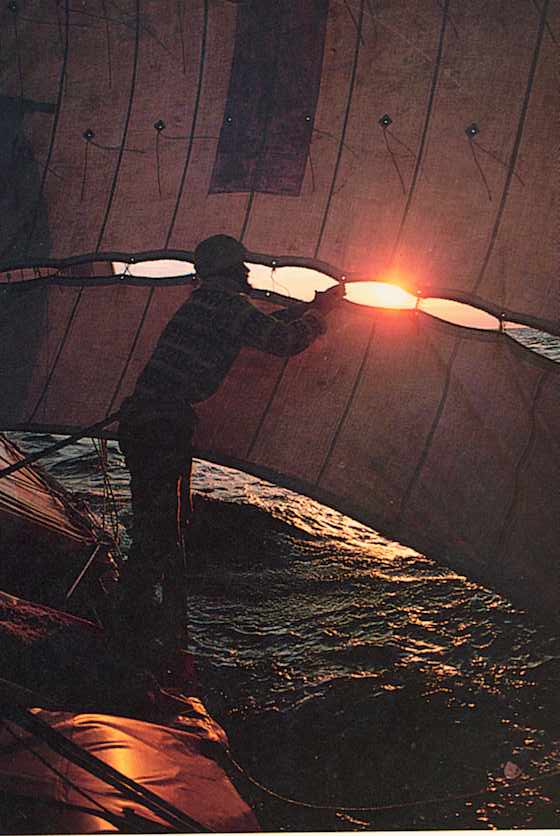The revived voyage in modern times ; Brendan Voyage by Tim Severin
After about 1400 years later, in the late twentieth century, one chap appeared who thought the Saint's voyage would have been a feasible one, if he built the exact replica of his curragh, made of leather and wood in similar manner and using same materials, and then tried to make an experimental voyage : the guy was an English writer and explorer, Tim Severin.
His specialty was history of exploration and geography during his Oxford days, when he traced back to the tracks made by the past explorers in history, then published the findings from his expeditions. His first book was Tracking Marco Polo (1961).
One day, Severin heard a casual remark from his wife, Dorothy ; 'it seems to me that the tex t(meaning Latin Navigatio Sancti Brendani) is not so much a legend as a tale that is embroidering a first-hand experience ... I don't see why Saint Brendan couldn't have got there.'
Severin's response to her comment was 'No, neither do I ... perhaps it's time someone tried to find out whether Saint Brendan's voyage was feasible or not.' So the idea of 'Brendan Voyage' was born.
This was how Saint Brendan's voyage was re-enacted ; many of the authorities on science of leather, however, warned him that such a boat made of leather would be rotten and then break down quickly if it were soaking wet in sea water.
Severin himself, however, believed in the credibility of the Latin Navigatio edited by Carl Selmer, saying '[They ( = Saint Brendan's company)] covered it with ox-hides tanned with the bark of oak and smeared all the joints of the hides on the outside with fat'* , received enthusiastic supports from the Reasearch Association of the British Leather Manufacturers, who arranged for him to meet two of traditional tanneries who produced the same way as in the Middle Ages in England. The tanners prepared some of samples of 'oak-bark-leather'and made a series of experiments, and the snippets proved the verity of the Navigatio, showing scientifically that the very leather tanned with oak-bark was water-tight, strong even when wet in salt water ; on the 'fat', the researckers revealed the fact that wool grease was the best suitable for dressing of the leather hides.
With fifty-seven 'butts' of oak-bark leather (of forty-nine butts used for the replica of Brendan's curragh), Severin discovered John O'Connel, earned for the best harnessmaker in Ireland, within the Cork City, where he lives, and then set about building of his replica at a renowned shipbuilder located in the same city. For the hull he adapted close-grained Irish ashes picked up for the purpose specially ; for the traditional 'double' gunwales, used oak, in a special manner precisely re-enacted for Irish curraghs. And then, just as if wearing some clothing, Severin's construction team stitched together the huge leather skins one by one, hand by hand, with 'fourteen cords' of Irish flax, all over the hull frames. It was a truly daunting task, but at last they finished rebuilding of the replica boat of Saint Brendan ; thus how was revivied, the ancient skin boat once seen along the western coastal region of Ireland.
May 17th 1976, the replica leather boat called Brendan, set sail from Brandon Creek of Dingle Peninsula, the legendary deperture point dipicted in the Navigatio, with the skipper Tim Severin and his crew of four, swaying with rolls left behind by the previous day's gale, for an answer --- whether the Saint's Voyage would have been a feasible one or not.
Modern replica of Irish traditional curragh Brendan, setting sail from Brandon Creek, 1976.
From a view of exploration history, Severin himself had firm belief that the possible passage used by the Irish would have been a so-called 'Stepping Stone Route' ; up north, to Iceland via the Hebrides, and then using the favourable current running down along the south coast of Greenland, his replica boat could sweep down toward off Labrador, reaching somewhere along the northeastern shore of North America. But the North Atlantic is notorious for 'graveyard of low pressures', the 'Magic Sea'of which sunk the famous luxury liner Titanic in 1912. People were aghast at hearing his attempt of crossing the North Atlantic by a fragile leather( ! )boat of only 36 feet overall, not a steel one, so one of them uttered such dire warning : they'll need a miracle more than Saint Brendan ever did !
Nevertheless, his replica leather boat scoffed at many of gloomy observations ; the flexible leather hull and ash ribs/frames absorbed high waves , as well as her shallow draught proved the safe passage across over hidden reefs like a surf boat. Moreover, the lower temperature of the sea as his vessel progressing toward Iceland made truly increasing the sea-going stability, with stiffening the layers of wool grease. Also Brendan refuted some of experts' claims that a leather boat must do re-dressing ashore in every week.
During the trans-Atlantic voyage, the Severin's crew were forced to live within the tiny leather boat with cold and rainy weather, just as if in a cell of an Irish monastery, but their lives aboard Brendan also provided some of Wonders of Nature : not only a vast shoal of pilot whales, or a sudden visit by a farocious killer whale, but another visit by still larger species like a blue whale or sperm whale within easy reach. On their approach toward the Faroes, numerous droves of lots of sea birds wheeling and swooping in a gale, just as the description of 'Paradise of Birds' in Navigatio.

above : Brendan anchored at Kirkjubø, Feroes.
Three months after the deperture from Ireland, Brendan carried Severin and his crew safely to Reykjavik Harbour, Iceland on July 17th, where they received an enthusiastic welcome by the offsprings of Northmen. But the sailing season for a westward voyage was already gone : due to unexpectedly premature arrival of pack ice off the southeastern coast of Greenland with spells of strong gales, Skipper Severin decided to delay his expedition into a second season, wintering Brendan over in Iceland.
Looking back at the previous season, Severin was acutely aware that the tools or materials available for medi&aecute;val monks were the best suitable for such task as a trans-Atlantic voyage under hostile weather conditions, which beat the modern tools or materials one after another, vividly contrasting the durability of the mediæval equipments. This is a point of view that you can never see until you are venturing on a similar voyage experiment, using the same vessel as the Irish. The same thing was applied to their diet ; modern 'dehydrated food' was so perishable when soaking wet in sprays, so they replaced them with tons of dried fruits or smoked or salt meat or chunks of whale blubber, back to mediæval food in the second season.
May 7th 1977, under the skipper Severin the crew of four men set out for the most dangerous, most difficult phase of thier voyage. For first days on board, the sea showed them dead calm, but soon later their boat was hit by a heavy gale, almost swamped, and on the verge of capsizing. Nevertheless, they survived, with the aid of the description of the Latin Navigatio, using spare oxhides for mending the hull for guarding battering rollers, and they managed to clear the major gales off the Greenland Sea.
When their leather boat entered the waters off Canada, the crew enclounted another similarity in the Navigatio, this time was heavy fog off the Gland Banks, causing Brendan off the chart at one point. Now Brendan was closing 100 miles off the coast of Newfoundland. The crew began to feel their long journey's end. However, past one midnight, they met sudden attacks by the vast packs of melting ice floes, swept down toward their boat by a gale. They were desperate for escaping from this nightmare, even prodding the ice floes, when one curious sound shook the whole boat ; the leather hull was holed, by a pincer assault of two of rigid ice floes. The vessel was leaking fast ; despite of their desperate efforts for bilge pumping, completely exhausted, when at last they discovered the cause of their distress ; fortunately the leaking hole could be patched neatly, so they set on the repair work, 'stitching' down on the port hull. The patch worked, and they continued the voyage.
Back to her proper sea-keeping ability, Brendan touched safely an uninhabited islet at 8:00 P.M., on June 26th, 1977, after 50 days out of Iceland, demonstrated that an ancient leather boat could have crossed the North Atlantic.

To the Land of Promise, New foundland, Canada, 1977.
Brendan off Labrador Peninsula, Canada, 1977.

Adjusting the flax sails

To the Land of Promise, New foundland, Canada, 1977.
* ... quote from the Voyage of Saint Brendan, trans. by John J. O'Meara, 1976.
The aftermath and Saint Brendan's Isle
Then, what was left behind by the re-enactment of Saint Brendan's voyage by Tim Severin ?
Severin himself adapted the so-called 'Stepping Stone Route', from west coast of Ireland all the way to the northeastern coast of North America, using a replica leather vessel to prove his theory was right by his expedition. There arises a question, however : the Latin Navigatio( ch.28 )states that Saint Brendan's 'voyage was for forty days towards the east', e.d., there are no accounts saying 'towards the west'. The original text can be understood literally that they set sail for the Promised Land of the Saints, located not so far off the northwest coast of Ireland, nor anywhere else far west off the North Atlantic.
So, the particular fact has led many scholars to hold that the real Brendan would not have reached North America. The believers of the presence of the Brendan's Promised Land such as Toscanelli or the Pizzigani brothers in the forteenth century, Richard de Bello( Richard of Haldingham or Lafford, the alleged creator of The Hereford Mappa Mundi ) saw the unknown land far off the Atlantic as the same Blessed Isles from the Hellenistic myths, each depicted his own Saint Brendan's Isle(s).
At first, the mapmakers' Brendan's Isles were located near off the Canaries, but their quest for such isle(s) in vain, so the Isle(s) were moving gradually across the Atlantic towards the unknown west, so this Isle(s) was held to be situated almost near off the shore of Newfoundland by mapmakers from the period of the John Cabot's expeditions. Fleet after fleet of such explorers tried to discover somewhere across the Atlantic, only to go back to their homelands, or at worst, shipwrecked on their return and lost their lives. Astonishingly, the last convoy of such believer-explorers in quest for the Brendan's Isle(s), was organised in 1721 !

The track of modern replica of Irish leather boat Brendan, 1976-77( click to open the original image )
Skipper Severin was convinced that Newfoundland must have been the Saint's Isle(s); in fact, it has been told taht such notion that the Stepping Stone Route brought the Irish's leather curragh all the way to North America is able to be traced back to some maps created around the Cabot's time. If so, then the miraculous re-enactment voyage led by Severin, in a word, proved nothing ?
Some of the ancient records left by the natives along the northeastern coastal regions of America indicate that there might have been the presence of the Caucasian people with Christian faith : for example, Erik's Saga states that men in white garments proceeded and yelled loudly, bearing the poles before them on which cloths were fixed. A few of the North settlers' documents like Erik's saga tell us that the presence of small bands of Christian Irish would have lived before their arrival ; some of them mentioned that their language were thought to be Irish, another even refered to 'Great Ireland' near off their settlement called 'Vinland'. However, these are all fragmantal tips on the possible evidence of the Irish people there, and no one has discovered any such relics by the Irish confirming those reports yet, anywhere along the eastern coast of North America.
I think it is the true contribution of the Brendan Voyage by Tim Severin that such re-enactment attempt successfully demonstrated that, for proper understanding of the highly advanced navigational ability of the mediæval seafaring monks of Ireland, you must adopt the same materials and the same methods as those people's, and trace back to their 'wake' --- so did Severin himself.
On Brendan, after the Voyage
The modern replica curragh Brendan, now at permanent rest in a quiet corner within a pre-historic park called 'Craggaunowen Project', located near the River Shannon( Abha na Sionainne ), Co. Clare, western Ireland. Below are some of the related links ;
|
© 2003 - 2025 Curragh. All rights reserved.


